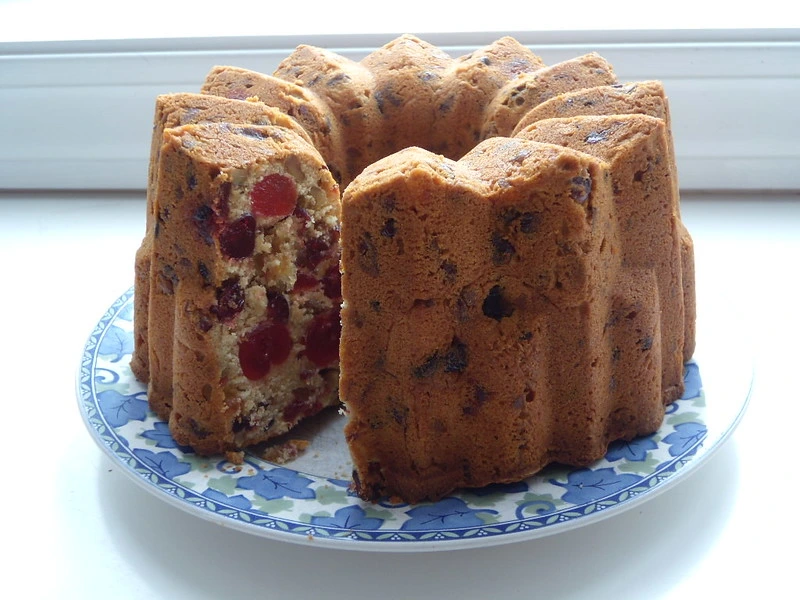The Best Fluffy Pancakes recipe you will fall in love with. Full of tips and tricks to help you make the best pancakes.
There’s something timeless about a classic fruit cake. Rich, dense, and bursting with the natural sweetness of dried fruits and warming spices, it’s a dessert that’s stood the test of time—especially during the holidays. Whether you grew up with it at Christmas dinners or are discovering it for the first time, this traditional treat brings comfort and celebration to every bite.
In this post, you’ll learn how to make a moist, flavorful fruit cake from scratch, packed with brandy-soaked fruits, toasted nuts, and festive spices. Perfect for gifting, serving at special occasions, or enjoying with a cup of tea, this recipe might just make you fall in love with fruit cake all over again.
Why Classic Fruit Cake Is Still a Holiday Favorite
Despite its reputation for being a love-it-or-hate-it dessert, classic fruit cake has remained a cherished tradition around the holidays for generations—and for good reason. Its rich history, impressive shelf life, and deeply festive flavor make it a standout on any celebration table.

A Recipe Rooted in Tradition
Fruit cake dates back to Roman times and evolved through the centuries into the dense, fruit-laden cakes we know today. In Europe, it became especially popular during the Victorian era, symbolizing wealth and festivity due to the expensive imported dried fruits, nuts, and spices used in the recipe. Today, fruit cake is a nostalgic staple for many families during Christmas, weddings, and milestone celebrations.
Packed with Flavor and Meaning
A good fruit cake is anything but bland. It’s a complex mix of textures and tastes—sweet dried fruits like raisins, apricots, and cherries, combined with crunchy toasted nuts, warm spices like cinnamon and nutmeg, and often a splash of brandy or rum for added richness. Each bite tells a story of tradition, patience, and care. Unlike most desserts, fruit cake improves with age, allowing its flavors to meld beautifully over time.
The Perfect Make-Ahead Holiday Treat
Fruit cake is ideal for busy holiday seasons because it can be made well in advance. In fact, many bakers prepare their fruit cakes weeks—or even months—before Christmas, feeding them with alcohol regularly to enhance the flavor and keep them moist. This long shelf life and aging process make it a practical and thoughtful gift that travels well and lasts.
A Celebration Dessert That Brings People Together
Whether enjoyed with a hot cup of tea on a quiet winter afternoon or served with whipped cream at a festive gathering, fruit cake has a way of bringing people together. It’s a symbol of hospitality and love—something handmade, hearty, and celebratory. Even those who claim not to like fruit cake often change their minds when they try a moist, well-made homemade version.
Key Ingredients That Make a Fruit Cake Rich and Flavorful
A truly great fruit cake starts with high-quality ingredients. It’s the thoughtful combination of dried fruits, nuts, spices, and sometimes a splash of spirits that transforms this humble dessert into something rich, indulgent, and unforgettable. Here’s a closer look at what gives fruit cake its signature taste and texture.
Dried Fruits: The Heart of the Cake
The star of any classic fruit cake is the medley of dried fruits. Traditional choices include raisins, currants, sultanas, chopped dates, figs, apricots, and glacé cherries. These fruits are often soaked in brandy or rum for several hours—or even days—before baking. This not only plumps them up but infuses the cake with deep, luxurious flavor.
Pro tip: Soaking your fruits overnight ensures a moist texture and prevents them from drawing moisture out of the cake batter during baking.
Nuts: Texture and Toasted Warmth
To add crunch and complexity, nuts such as walnuts, almonds, or pecans are commonly included in fruit cake. Lightly toasting them before folding into the batter intensifies their flavor and gives a satisfying contrast to the chewy dried fruits. Chop them roughly to ensure every bite offers a balanced texture.
Spices: A Warm Embrace of Holiday Flavor
What would fruit cake be without the warming touch of cinnamon, nutmeg, allspice, and cloves? These spices create a comforting, aromatic base that enhances the sweetness of the fruits and the richness of the cake. Don’t go overboard—just the right balance adds depth without overpowering the other ingredients.
Citrus Zest and Peel: A Bright Lift
To balance the richness, many traditional recipes include orange or lemon zest, and sometimes candied citrus peel. These elements brighten the flavor profile and cut through the heaviness, giving the cake a more complex and well-rounded taste.
Optional but Flavorful Additions
- Brandy or Rum: Used both in soaking fruits and for brushing the cake during the aging process. This not only preserves the cake but also adds a smooth, boozy richness.
- Marzipan: Often used to top the fruit cake before icing, adding a sweet almond layer that complements the other flavors.
- Brown sugar or molasses: Deepens the sweetness and gives the cake a rich, caramel-like undertone.
Each ingredient in a fruit cake serves a purpose, creating a dense, moist, and flavorful dessert that only gets better with time. When chosen thoughtfully, these components work together in perfect harmony.
Step-by-Step: How to Make a Moist and Delicious Fruit Cake
Making a fruit cake from scratch may seem intimidating, but with the right steps, it’s surprisingly easy—and incredibly rewarding. The key to success lies in proper preparation, a gentle baking process, and patience. Here’s a simple guide to help you craft a moist, flavorful fruit cake your guests will rave about.
1. Soak the Dried Fruits (Ideally Overnight)
Start by selecting a variety of dried fruits like raisins, currants, chopped dates, cherries, and apricots. Place them in a bowl and soak them in brandy, rum, or orange juice for at least 6–8 hours—or overnight for best results. This softens the fruit and allows it to absorb flavor, ensuring it stays juicy and moist when baked.
Optional: Add citrus zest or a cinnamon stick to the soaking liquid for an extra layer of flavor.
2. Prepare the Cake Batter with Care
Cream together room-temperature butter and brown sugar until light and fluffy. Beat in eggs one at a time, mixing well between each addition. This creates a rich base that binds the dense fruit and nut mixture together.
In a separate bowl, whisk together the dry ingredients: all-purpose flour, baking powder, salt, and a blend of warm spices like cinnamon, nutmeg, and allspice.
Slowly fold the dry mixture into the wet, being careful not to overmix. Then gently stir in the soaked fruits (drained if necessary) and your choice of toasted chopped nuts. If the batter feels too thick, a splash of milk or orange juice can help loosen it just enough to pour into the pan.
3. Choose the Right Pan and Bake Low and Slow
Fruit cakes are traditionally baked in a loaf pan or deep round/bundt pan, which gives them their dense, compact shape. For best results, line your pan with parchment paper and lightly grease it to prevent sticking. If you’re looking for a high-quality pan, this Ninja NeverStick Premium Bakeware Loaf Pan is an excellent choice.
Pour the batter in and bake at a low temperature (around 275°F / 135°C to 300°F / 150°C). This slow baking method ensures the cake cooks evenly without drying out. Depending on the size of your pan, it can take anywhere from 1.5 to 2.5 hours.
Tip: Insert a skewer into the center of the cake—it should come out clean or with a few moist crumbs.
4. Cool, Wrap, and Age for Flavor
Once baked, let the cake cool completely in the pan before removing it. Then, if you’re planning to age the cake, wrap it tightly in parchment paper and foil. Store it in an airtight container in a cool, dry place. For a boozy version, brush the cake with a bit of brandy or rum every week. This not only preserves the cake but also enhances the flavor over time.
A well-aged fruit cake (about 2–4 weeks) develops a deep, complex taste that makes it even more delicious by the time you serve it.
Expert Tips to Perfect Your Homemade Fruit Cake
A perfectly baked fruit cake is a labor of love—and a true celebration of flavor and tradition. To help you master this holiday classic, here are expert tips that will take your homemade fruit cake from good to unforgettable.
1. Always Soak Your Fruits in Advance
Soaking is the secret to a moist and flavorful fruit cake. Whether you use brandy, rum, orange juice, or even apple cider, allow the fruits to absorb the liquid overnight. This plumps them up and infuses the entire cake with rich, aromatic depth.
Tip: Store leftover soaked fruits in an airtight container in the fridge for up to a week—they only get better with time.
2. Don’t Overmix the Batter
Overmixing the batter can lead to a dense, dry cake. Once you’ve creamed the butter and sugar and incorporated the eggs, gently fold in the dry ingredients and fruit mixture just until combined. This helps maintain the cake’s tender structure and prevents it from becoming tough.
3. Bake at a Low Temperature for Even Cooking
Fruit cakes are dense and full of moisture, so they need to be baked slow and low. A temperature of 275–300°F (135–150°C) prevents the outside from burning while allowing the inside to cook through evenly.
Bonus Tip: Place a pan of hot water on the bottom rack of the oven to add moisture and prevent the cake from cracking.
4. Use Parchment Paper for Easy Removal and Even Edges
Line your baking tin with parchment paper on the bottom and sides. This not only helps the cake release easily from the pan but also keeps the edges from becoming too dark. You can even wrap the outside of the pan with brown paper or an extra parchment collar to protect the cake during its long bake.
5. Age Your Cake for Better Flavor (Optional but Worth It!)
Aged fruit cake is traditional—and truly magical. Once your cake has cooled completely, wrap it in parchment paper and foil, and store it in an airtight container in a cool, dark place. Every week, brush it with a little alcohol (brandy or rum) to enhance flavor and preserve moisture. After 3–4 weeks, the cake becomes rich, mellow, and beautifully matured.
6. Add a Personal Twist
Want to make your fruit cake unique? Try:
- Swapping brandy for spiced rum or orange liqueur.
- Adding chopped dark chocolate for a hint of indulgence.
- Incorporating candied ginger or tropical fruits like pineapple or mango for a fruity flair.
7. Decorate Simply but Elegantly
Classic fruit cakes are often topped with a layer of marzipan and royal icing. You can also decorate with whole nuts, dried fruits, or candied citrus slices for a rustic and festive finish. Just remember to let the cake fully cool before icing or decorating.
Frequently Asked Questions About Fruit Cake
Fruit cake is one of those timeless holiday treats that sparks curiosity and, sometimes, a few strong opinions. Whether you’re new to baking it or revisiting a classic family recipe, here are answers to the most common fruit cake questions to help you bake (and enjoy) with confidence.
1. Why Does Fruit Cake Have a Bad Reputation?
Fruit cake has often been criticized for being dry, overly sweet, or packed with artificial candied fruits. But when made correctly—with quality ingredients, balanced flavors, and proper technique—it’s moist, flavorful, and truly delicious.
The key is to use real dried fruits, natural citrus zest, and avoid overbaking. A well-made fruit cake can win over even the most skeptical guests.
2. How Long Does Fruit Cake Last?
One of the biggest advantages of fruit cake is its long shelf life. Thanks to its dense texture and preservative qualities from alcohol, a traditional fruit cake can last:
- Up to a month at room temperature when wrapped and stored properly.
- 3 to 6 months in the refrigerator.
- Over a year if aged and stored in a cool, dark place, with regular alcohol “feedings.”
If your cake is alcohol-free, it should be refrigerated and enjoyed within a few weeks.
3. Can I Make Fruit Cake Without Alcohol?
Absolutely! For a non-alcoholic version, soak your fruits in fruit juice (like orange or apple juice) or brewed tea. The flavor will still be rich and satisfying, and you can add extra spices or a touch of molasses for depth.
Just keep in mind that alcohol helps with preservation, so non-alcoholic fruit cakes should be eaten sooner or stored in the fridge.
4. Why Does My Fruit Cake Sink in the Middle?
A sunken center is usually a sign of:
- Overmixing the batter, which can knock out necessary air.
- Opening the oven door too early, causing the cake to collapse.
- Too much leavening agent, leading to rapid rising and sinking.
To avoid this, gently fold in ingredients, keep the oven door closed during baking, and measure your baking powder carefully.
5. How Do I Keep My Fruit Cake Moist?
Moisture is key to a perfect fruit cake. Here’s how to keep it moist:
- Soak fruits beforehand so they don’t pull moisture from the batter.
- Bake slowly at a low temperature.
- Store wrapped in parchment and foil.
- Brush with alcohol or syrup if storing long term.
If you’re aging the cake, weekly feeding with brandy or juice keeps it beautifully tender.
6. When Is the Best Time to Make Fruit Cake for the Holidays?
For the holidays, it’s ideal to make your fruit cake at least 4–6 weeks in advance. This gives the cake time to mature, develop flavor, and absorb the alcohol if you’re feeding it regularly.
But don’t worry—if you’re in a rush, you can still bake and serve a delicious fruit cake within a day or two. Just be sure to let it cool completely before slicing.
7. Can I Freeze Fruit Cake?
Yes! Fruit cake freezes beautifully. Wrap it tightly in plastic wrap and foil, then place it in a freezer-safe container or bag. It can be frozen for up to a year. To serve, thaw it slowly in the refrigerator or at room temperature.





